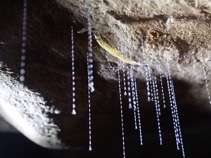New Zealand glowworms' sticky 'fishing lines' use moist, urea droplets to trap prey

The sticky fishing lines produced by New Zealand glowworms to trap their insect prey are spaced with water-absorbent droplets containing urea, according to a study published December 14, 2016 in the open-access journal PLOS ONE by Janek von Byern from the Ludwig Boltzmann Institute for Experimental and Clinical Traumatology, Austria, and colleagues.
Spiders' webs may be the best known sticky substances produced by animals, but other species use adhesive secretions in many and varied ways. Larvae of the glowworm group Arachnocampa are known to secrete threads spaced with adhesive droplets, forming a sticky curtain to trap the insects which are attracted to their glowing tail light. However, the properties of these 'fishing lines' had not previously been characterized in detail.
The authors of the present study analyzed the fishing lines of glowworms collected from two caves on New Zealand's North Island, using scanning electron microscopy and X-ray spectroscopy to determine their morphology and their molecular composition.
The researchers found that the glowworms' adhesive threads were very different from the webs woven by spiders, featuring very moist, water-absorbent droplets. This likely reflects their different environments: spiders often exist in dry sites whereas Arachnocampa glowworms can only survive in humid habitats such as caves and forests. The absorbent droplets found in glowworms' fishing lines may extract atmospheric water to help the glowworms to avoid desiccation.
Whereas spiders spin silk from abdominal glands, glowworms secrete fishing lines from their mouthparts. However, the authors noted that the lines' adhesive droplets contained mineralized crystals including urea, so the droplets might be produced in the midgut and incorporate components of the glowworms' primary urine. The authors hope that further research will examine how the habitats of different glowworm species shape the fishing lines and adhesive droplets that they produce.
"Characterization of the adhesive threads of the world-renowned glowworm from New Zealand display a complete different prey capture system to those found in spiders or other glue-producing animals," says von Byern. "These bioadhesives display a unique composition contain mainly water, hygroscopic salts, and to a very low extent also biomolecules as proteins and lipids."
More information: von Byern J, Dorrer V, Merritt DJ, Chandler P, Stringer I, Marchetti-Deschmann M, et al. (2016) Characterization of the Fishing Lines in Titiwai (=Arachnocampa luminosa Skuse, 1890) from New Zealand and Australia. PLoS ONE 11(12): e0162687. DOI: 10.1371/journal.pone.0162687
Journal information: PLoS ONE
Provided by Public Library of Science




















